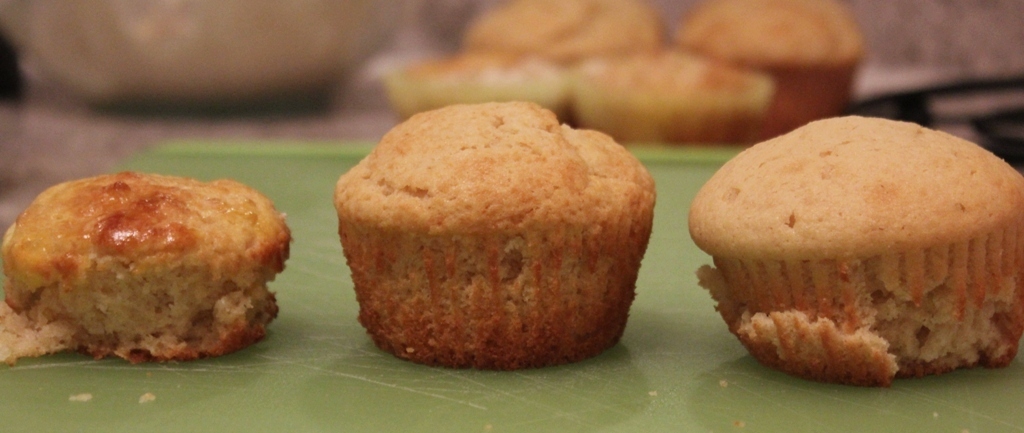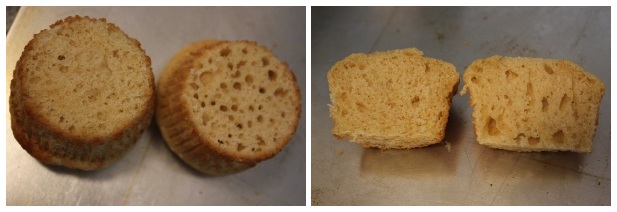

Gluten: It's an important component in the structure and texture of baked goods as we know them. Gluten is mostly found in wheat and, to a lesser extent, in barley and rye. What is it? Well, it's a protein -- or more technically speaking, it's a group of two proteins, glutenin and gliadin, bonded to form a network (1). This network gives structure and function to doughs and batters. They give dough the elasticity (ability to retain its shape) and plasticity (ability to be molded, as in clay) that make baked goods so unique and amazing (2).
Here's how it happens: when water is added to flour, glutenin and gliadin are able to move freely and form bonds with other glutenin and gliadin molecules, thereby creating a network of protein (that's gluten!). Working the dough or batter by kneading or stirring creates more bonds and strengthens the gluten network (3). Some baked goods require a lot of gluten formation, like bread and pizza dough; others require minimal formation of gluten, like cake and muffins. That's why bread recipes call for lots of kneading, whereas cake and muffins are stirred only enough to moisten the dry ingredients. This is all for the sake of gluten formation!
Let's look closer at those examples. When making bread or pizza dough, you're supposed to "work" or "knead" the dough. Kneading causes a large gluten network to form. That network is a strong, expandable structure that can hold lots of air during rising, yields a baked product that is sturdy enough to allow for extra toppings or sandwich contents without falling apart. In contrast, tenderness is the goal when it comes to cake and muffins. Here, you're supposed to stir the batter only enough to moisten the ingredients. Working the batter so little limits the ability of gluten to form. A smaller, weaker network gives just enough structure for the muffin or cake to hold its shape, but allows the finished product to be tenderer and more crumbly (see the Muffin Method).
The photo below depicts an under-beaten, correctly beaten, and over-beaten muffin. You can see the lumpy, dense texture of the under-beaten muffin on the left. Its shiny top is caused by undistributed egg. The center muffin is correctly prepared, and looks normal. The muffin on the right is over-beaten, and has too much gluten. The excess gluten gives it a smoother, stiffer crust, which is not typically desirable in a muffin. In addition, the extra gluten allows steam to form large tunnels (called tunneling) in the muffin, which can cause it to buckle and collapse, as it did here.

Here are cross-sections of two muffins. The muffin on the left is prepared properly, and the one on the right is over-beaten. You can clearly see the tunneling in the over-beaten muffin, both from the bottom and the side views.

But there's more to gluten formation than just stirring! The type of flour you're using matters too: cake flour, pastry flour, all-purpose flour, bread flour, durum semolina (for pasta); the list goes on. What's the difference between these? Gluten! Well, technically since gluten isn't formed until water is added, let's refer to it as protein.
Each type of flour has a unique protein make-up, but at this point, it's also important to note that the leftover (non-protein) portion of white wheat flour is mainly starch, which provides the soft, moisture-retaining bulk of baked goods by gelatinizing around the gluten skeleton (4). Knowing that white flour is essentially a starch-protein blend comes in handy if you have the wrong type of flour and would like to make a substitution. (See gluten-taming tip #2 below.)
Here's a breakdown of the approximate protein levels of these wheat flours (5):
Cake: 7-8 percent
Pastry: 8-9 percent
All-purpose (US national brands): 11-12 percent
Bread: 12-13 percent
Durum semolina: 13 percent
But it's not just as simple as knowing the approximate quantity of protein in these types of flour. The quality of protein can vary as well. For example, durum semolina flour, which is used in pasta, doesn't contain significantly more protein than bread flour. Why differentiate? Because in durum semolina has more stiff, brittle proteins like glutenin, which create a dense texture with stiffer chew, perfect for pasta. On the other hand, bread flour has more soft, flexible proteins like gliadin, which create a dough that's more stretchy than brittle (6).
Even among all-purpose flours there can be some differentiation. For instance, if you use a regional brand of flour, particularly in the Pacific Northwest or the South, your protein content is often closer to 7.5-9.5 percent (7). This could explain why your niece in Portland could never get her bread to look quite the same as yours in Boston, even though she used your exact recipe. Similarly, if you dine in Europe, you'll be sure to appreciate their crusty baguettes, but you might notice they make a lousy muffin. Why? They may use the same recipes as we do in America, but European wheat has a stiffer protein content (higher in glutenin) than our more delicate American wheats (higher in gliadin). So, even with the same recipes, we find it difficult to perfectly replicate their crusty breads and they find it difficult to mimic the tenderness of our muffins.
Gluten-taming tips:
Gluten-taming tip #1: Working your dough or batter. Knead your dough according to recipe specs. Kneading more or less will impact the amount of gluten formed and thereby impact your final texture and appearance. (This goes for stirring as well.)
Gluten-taming tip #2: Choose your flour wisely! If your recipe calls for pastry flour but you only have all-purpose, you know what the difference is! If you simply substitute all-purpose flour for pastry flour, you'll have too much protein in your dough and your product will come out tough (unless of course you're using a local brand from the South or Pacific Northwest). All is not lost, however. As I mentioned earlier, wheat flour is basically just starch and protein. So if the flour you have on hand has too much protein, you could substitute plain starch (corn starch will usually do just fine) for a portion of your flour to bring the overall protein content down. Alternatively, if your recipe calls for bread flour but you only have all-purpose, you would need to compensate by adding something called vital wheat gluten. This is basically gluten that's been separated from regular flour. Most vital wheat gluten is 70-85 percent gluten (8). Making adjustments yourself to the protein content of your flour is not likely to be very precise, as each brand will differ somewhat in protein content to begin with. However, it's a great trick to have up your sleeve in a pinch. For example, I might employ the technique of substituting starch for a portion of my flour if I had a brownie recipe that consistently came out a little dry or lacking in tenderness. Instead of buying pastry flour, I could just tweak the flour to be tenderer by using ingredients I already have on hand. (Of course, there are other factors that can impact tenderness too. Click here to see a troubleshooting chart.)
Gluten-taming tip #3: Using whole wheat instead of white: Whole wheat flour varies in protein content more than white flour. It can contain anywhere from 11-15 percent protein (9). However, the bran acts as a physical barrier to gluten formation in the dough and therefore will result in denser products with less ability to rise (10). You can compensate for this by using additional leaveners, and by allowing half of the flour used in any whole-wheat recipe to be white. Another thing to note about whole wheat flour is that it contains fats that are normally removed in the processing of white flour (11). These fats are prone to rancidity (producing off flavors and smells), and as a result, whole wheat flour has a much shorter shelf life. Protecting it from light and heat exposure can slow down this process. Keeping your whole wheat flour in the fridge will make it last longer.
A nutritional note: The methods for controlling gluten formation outlined in this article are meant to relate only to how gluten impacts food, not how it impacts your body. If you are on a gluten-free diet, you should continue to avoid wheat, barley and rye products altogether. Always consult your doctor before making major changes in your diet.
References:
1. Amy Brown, Understanding Food: Principles and Preparation, 2nd Edition (Belmont: Wadsworth/Thomson Learning, 2004), 402-406
2. Harold McGee, On Food and Cooking: The Science and Lore of the Kitchen (New York: Scribner, 2004), 522-523
3. Brown, Understanding Food, 402-403
4. McGee, On Food, 525
5. McGee, On Food, 527
6. "Wheat Matters, and Here's Why", King Arthur Flour, accessed March 8, 2013, http://www.kingarthurflour.com/recipe/grains.html.
7. McGee, On Food, 530
8. McGee, On Food, 530
9. McGee, On Food, 530
10. Brown, Understanding Food, 406
11. Brown, Understanding Food, 406